|
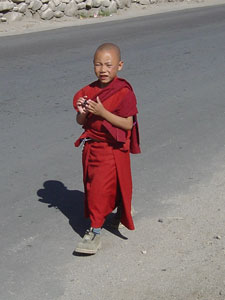 Ladakh - Buddhist novice
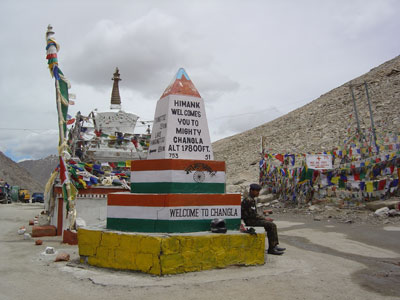 Changla Pass in the eastern highlands of Ladakh
The mountain track was a nightmare in broad daylight. Mud and rocks all over, large strips of asphalt washed away by icy water that rushed down from the steep slopes and disappeared over the edge of the abyss on the other side. My Ladakhi driver at the wheel of his old land rover was used to it and didn't lose his nerve. Then there was that heavy bump and the sharp sound of scraping metal. My driver lost his oriental smile, he spat out a curse in his Tibetan idiom and stopped the vehicle. Bad luck, a broken spring. After a while we hobbled on and finally reached the top of the mountain pass. It was the mighty Changla at an altitude above 5.000 metres in the eastern highlands of Ladakh, in the direction of the Tibetan border.
My Ladakhi driver performed a small miracle on the spot - he repaired the broken spring with a pair of pincers and a piece of iron wire he found near the stone monument and the Buddhist stupa at the top of the Changla. He was smiling again. No problem, and we were lucky, so he said, the weather was bright. I watched the heavy grey clouds drifting by and wondered what bad weather was like in these parts on the roof of the world. On we went, taking the long and winding descent towards the village of Tangtse.
 Tangtse - the hamlet with the boulders
Tangtse is a tiny settlement in the middle of nowhere. Along its main street there are a couple of small guesthouses that provide basic accomodation for foreign visitors on their way to Pangong Lake at the Tibetan border. Tangtse is also the site where rock inscriptions have been preserved. My Ladakhi driver assured me that he knew the exact location. So, we left the village and followed the road to Pangong Lake. Then he stopped the car and pointed at some multicoloured graffiti. It was the well-known Buddhist mantra Om Mani Padme Hum, Praise the Jewel in the Lotus, recently painted in Tibetan script characters on a huge rock above the road. Most probably the work of pious locals or present day believers from abroad, but certainly not the mysterious and age-old inscriptions I was looking for. We drove back, I stepped out of the car and told the driver that he was free for the rest of the day.
Exploring on foot seemed the best way, the slow way of the ancient travellers along the Silk Road. It was the right decision. I reached a small hamlet, just a few mud houses at the edge of the village. It was a magnificent site - enormous boulders lying there close to the stone fences of these shabby houses, in a timeless landscape surrounded by barren mountain peaks. Splendid scenery drenched in solitude. I walked around the boulders and there it was on one of them - the Sogdian rock inscription with the three Nestorian crosses.
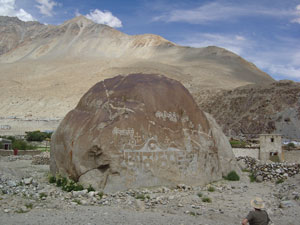 Tangtse - rock inscriptions
In the period after Alexander the Sogdian territory became part of the kingdom of the Bactrian Greeks. Then Christianity came to these regions. It was the oriental form of Christianity, adopted by the Nestorian Church of the East, which flourished in Persia till the tenth century. Nestorian missionaries followed the Silk Road to Central Asia, they founded Christian communities and preached among the Sogdians.
In those days Sogdian merchants controlled the trade along the Silk Road in Central Asia and converted Sogdians spread Nestorian Christianity in these parts. The Nestorian Church used Syriac, the old Aramaic language, for its liturgy. Sogdian converts translated these sacred texts into their own Irano-Aryan language and so they were preserved, till the storms of history - invasions of nomadic Central-Asian tribes, Buddhist reaction and the rise of Islam - swept away this christianized Sogdian civilization and buried it under the desert sands of Central-Asia. Few relics survived. One of them is the Sogdian rock inscription at Tangtse.
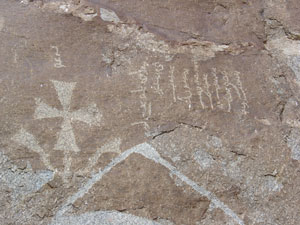 Sogdian text & Nestorian Cross
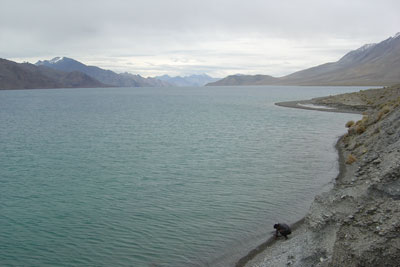 Pangong Lake close to Tibetan border
The next day Pangong Lake was my final destination. My Ladakhi driver was in great shape and we reached the lake after a few hours' drive. I never saw a more desolate place. The greyish blue water surface motionless, like melted ice. A glimpse of blue in the clouded sky at the distant shore and farther away the snow-capped mountains of Tibet. Centuries ago a Nestorian monk stood there, measuring the distance and the difficulties that lay ahead.
Tangtse, the next day. It was July, but the weather had changed and it was a tough ride back. At the top of the Changla Pass we had to slide our way through a snowstorm and it took us several hours before we reached the lower valley with the main road leading to Leh. The rain kept pouring down for the rest of the day. It was the anticlimax of a summer trip through the highlands of eastern Ladakh, in search of a rock with three Nestorian crosses.
Text & illustrations - August Thiry
|

 Homeland
Homeland  East of Eden
East of Eden  Ladakh Inscriptions
Ladakh Inscriptions

 Homeland
Homeland  East of Eden
East of Eden  Ladakh Inscriptions
Ladakh Inscriptions